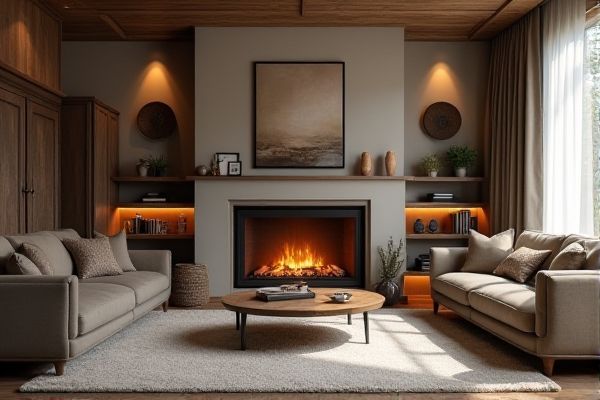
Built-in fireplaces offer a traditional, permanent heating solution with natural flames and real wood or gas options, providing a cozy ambiance and higher heat output. Electric fireplaces are versatile, easy to install, and require minimal maintenance, making them convenient for any space; discover which option best suits your home by reading the rest of this article.
Table of Comparison
| Feature | Built-in Fireplace | Electric Fireplace |
|---|---|---|
| Installation | Requires professional installation and structural changes | Easy to install, plug-and-play, no structural change needed |
| Heat Source | Burns wood or gas for real flame and heat | Electric heating element with realistic flame effects |
| Maintenance | Requires regular chimney cleaning and ash removal | Minimal maintenance, no chimney or ash |
| Cost | Higher initial and operational costs | Lower upfront cost and energy efficient |
| Safety | Open flame and hot surfaces, risk of carbon monoxide | Safer with no real flame, cool to touch options |
| Environmental Impact | Emits smoke and pollutants | Environmentally friendly, zero emissions |
| Heat Output | High heat output suitable for heating rooms | Moderate heat, ideal for supplemental heating |
| Appearance | Authentic flame with classic aesthetic | Variety of designs with customizable flame effects |
Introduction to Built-in and Electric Fireplaces
Built-in fireplaces offer a permanent, integrated heating solution with traditional aesthetics and efficient heat distribution, often enhancing your home's architectural design. Electric fireplaces provide versatile, low-maintenance options with customizable flame effects and easy installation, perfect for supplemental heating. Your choice depends on preferences for authenticity, installation complexity, and energy efficiency.
Design and Aesthetic Differences
Built-in fireplaces offer a traditional, seamless integration with your home's architecture, featuring materials like brick, stone, or tile that provide a classic, cozy ambiance. Electric fireplaces prioritize sleek, modern designs with customizable LED flames and minimal installation requirements, making them versatile for various interior styles. Your choice affects the room's focal point, balancing authentic warmth versus contemporary convenience.
Installation Process and Requirements
Built-in fireplaces require professional installation involving venting, structural modifications, and adherence to local building codes, which can increase upfront costs and time. Electric fireplaces offer a straightforward setup, often needing only a power outlet without special venting or construction work, making them ideal for renters or those seeking a quick upgrade. Your choice depends on your home's infrastructure and flexibility in installation complexity.
Heating Efficiency and Performance
Built-in fireplaces provide superior heating efficiency by radiating warmth directly from a combustion source, often fueled by gas or wood, resulting in higher heat output and sustained warmth. Electric fireplaces offer user-friendly heating with rapid heat-up times, adjustable thermostats, and energy-efficient LED flames, but typically generate less heat compared to built-in models. The choice depends on the desired heat volume and installation constraints, with built-in fireplaces excelling in performance for larger spaces and electric versions suitable for supplemental or zone heating.
Cost Comparison: Initial and Ongoing Expenses
Built-in fireplaces typically require higher initial costs due to professional installation, masonry work, and potential structural modifications, making them a significant investment upfront. In contrast, electric fireplaces offer a lower initial price and are easier to install, often without the need for specialized labor. Your ongoing expenses for built-in fireplaces include fuel or gas and regular maintenance, while electric models generally incur minimal costs, primarily electricity, making them more budget-friendly over time.
Energy Consumption and Environmental Impact
Built-in fireplaces typically consume more energy due to their reliance on natural gas or wood, which can produce higher carbon emissions and contribute to indoor and outdoor air pollution. Electric fireplaces use less energy by converting electricity directly into heat, offering greater efficiency and producing no direct emissions, making them a more environmentally friendly option. Choosing electric fireplaces can significantly reduce energy consumption and minimize the carbon footprint compared to traditional built-in fireplaces.
Safety Features and Concerns
Built-in fireplaces offer robust safety features such as fire-resistant materials and ventilation systems that reduce risks of carbon monoxide buildup, whereas electric fireplaces eliminate combustion hazards entirely by using LED heat elements and cool-to-the-touch surfaces. Electric fireplaces provide enhanced safety controls including automatic shut-off timers and overheat protection, making them suitable for homes with children or pets. Despite these benefits, built-in fireplaces require regular maintenance to ensure chimney and gas line safety, while electric models demand less upkeep but may pose minor electrical risks if not properly installed.
Maintenance and Durability
Built-in fireplaces generally require regular chimney cleaning and professional inspections to prevent creosote buildup, ensuring long-term safety and durability, while electric fireplaces demand minimal maintenance, primarily occasional dusting and checking electrical components. You will find that electric models offer more consistent performance with fewer risks of wear, as they lack combustible materials and complex venting systems. Built-in options provide a classic ambiance but may incur higher upkeep costs over time compared to the virtually maintenance-free electric fireplaces.
Smart Features and Technological Integration
Built-in fireplaces commonly integrate advanced smart home compatibility, allowing seamless control through voice assistants like Alexa or Google Assistant for temperature and flame adjustments. Electric fireplaces offer enhanced technological integration with customizable LED lighting, remote operation, and app-based controls that adjust heat settings and ambiance in real-time. Both options increasingly emphasize energy-efficient designs combined with programmable timers and safety features to optimize user convenience and smart home connectivity.
Choosing the Right Fireplace for Your Home
Built-in fireplaces, known for their traditional aesthetic and permanent installation, provide efficient heat output through gas or wood fuel, enhancing home value and ambiance. Electric fireplaces offer versatile placement, easy installation, and lower maintenance with safety features, ideal for renters or modern interiors requiring supplemental heat. Consider your home's heating needs, design preferences, and installation feasibility to select the fireplace type that best balances functionality and style.
 homyna.com
homyna.com